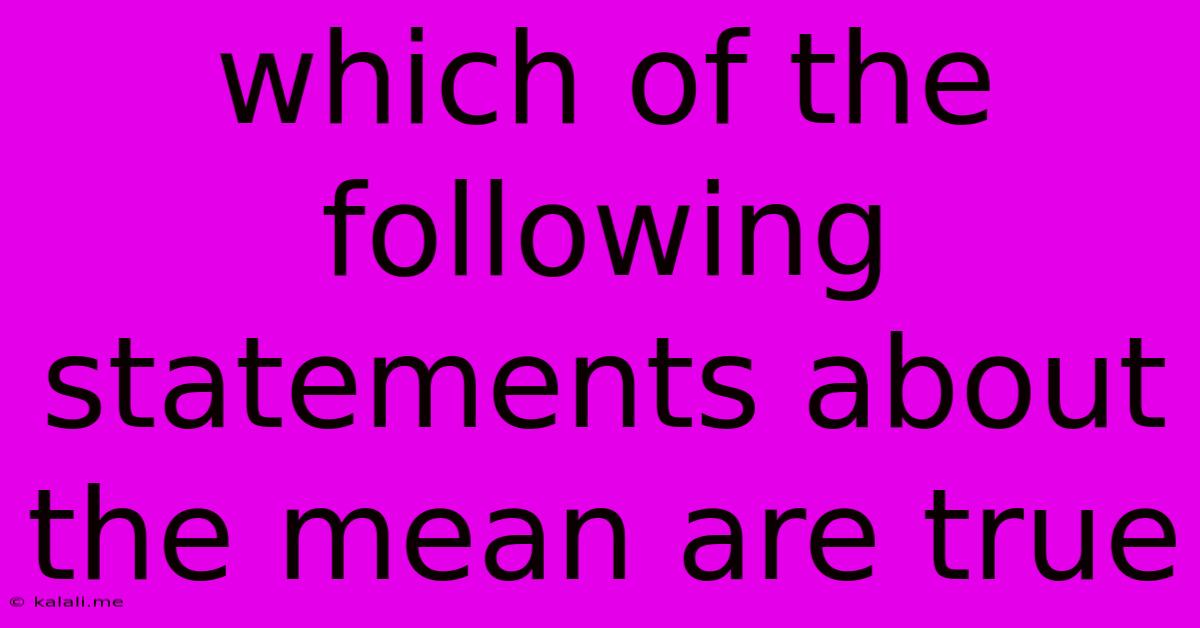Which Of The Following Statements About The Mean Are True
Kalali
Jun 16, 2025 · 3 min read

Table of Contents
Which of the Following Statements About the Mean Are True? A Comprehensive Guide
The mean, also known as the average, is a fundamental concept in statistics used to represent the central tendency of a dataset. Understanding its properties is crucial for data analysis and interpretation. This article will explore common statements about the mean and determine their truthfulness, providing a clear understanding of this essential statistical measure. We'll delve into its calculation, its sensitivity to outliers, and its relationship to other measures of central tendency.
What is the Mean?
The mean is calculated by summing all the values in a dataset and then dividing by the number of values. This provides a single value representing the "typical" or "average" value within the dataset. For example, the mean of the numbers 2, 4, and 6 is (2+4+6)/3 = 4.
Common Statements About the Mean and Their Truthfulness
Let's examine some frequently encountered statements regarding the mean and assess their accuracy:
1. The mean is always the best measure of central tendency.
False. While the mean is widely used, it's not always the best measure. Its sensitivity to outliers (extremely high or low values) can significantly distort the representation of the central tendency. For example, in a dataset with mostly values around 10 but one outlier of 1000, the mean would be heavily influenced by the outlier, giving a misleading representation of the typical value. In such cases, the median (the middle value when data is ordered) or the mode (the most frequent value) might be more appropriate.
2. The mean is easily affected by outliers.
True. As mentioned above, the mean is susceptible to outliers. Extreme values can disproportionately influence the mean, pulling it away from the central cluster of data points. This sensitivity is a crucial consideration when analyzing datasets that might contain outliers. Robust measures of central tendency, less sensitive to outliers, should be considered in such scenarios.
3. The sum of deviations from the mean is always zero.
True. This is a fundamental property of the mean. The deviations are the differences between each data point and the mean. The positive deviations (values above the mean) always cancel out the negative deviations (values below the mean), resulting in a sum of zero. This property is used in various statistical calculations and proofs.
4. The mean can be calculated for both numerical and categorical data.
False. The mean is only applicable to numerical data (data that can be measured or counted). Categorical data (data representing categories or groups, like colors or types of fruit) cannot be directly summed or averaged. For categorical data, measures like mode are more suitable.
5. The mean is always within the range of the data.
True. The mean will always fall somewhere between the smallest and largest values in the dataset. This is because it's a weighted average of all the data points.
6. The mean is a good measure of central tendency when the data is normally distributed.
True. For datasets following a normal (bell-shaped) distribution, the mean is a highly representative measure of central tendency. It coincides with the median and mode in a perfectly symmetrical normal distribution.
Conclusion:
Understanding the properties of the mean is essential for accurate data analysis. While it's a valuable tool, its limitations, particularly its sensitivity to outliers, must be carefully considered. Choosing the most appropriate measure of central tendency depends on the characteristics of the dataset and the specific research question being addressed. Knowing when and how to use the mean effectively is a key skill for anyone working with data.
Latest Posts
Latest Posts
-
Which Of The Following Statements Is True Of Lake Victoria
Jun 16, 2025
-
Which Of The Following Best Describes A Body In Equilibrium
Jun 16, 2025
-
50 Of What Number Is 80
Jun 16, 2025
-
What Is The Si Unit Of Displacement
Jun 16, 2025
-
Lcm Of 6 4 And 10
Jun 16, 2025
Related Post
Thank you for visiting our website which covers about Which Of The Following Statements About The Mean Are True . We hope the information provided has been useful to you. Feel free to contact us if you have any questions or need further assistance. See you next time and don't miss to bookmark.